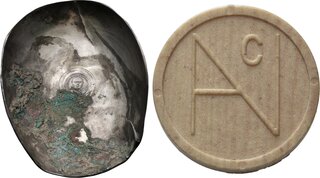| Numismatica Ars Classica > Auction 146 | Auction date: 8 May 2024 |
| Lot number: 2398 Price realized: This lot is for sale in an upcoming auction - Bid on this lot  | Show similar lots on CoinArchives Find similar lots in upcoming auctions on |
| Lot description: Licinius I augustus, 308 – 324. Medallic silver bowl of one Roman pound, Ephesus 1 March 322, AR 200 mm, 330 g. Silver bowl with simple curved profile. In the centre is a struck medallion within a lathe-cut circle: LICINIVS AVG OB D V LICINI FILI SVI Bare-headed, draped, and cuirassed facing bust of Licinius I. On the outside of the bowl, near the rim, is a small round stamp: EUG/EFE/MEB in three lines. For three medallic bowls of the same issue, cf. J.P.C. Kent and K.S. Painter, Wealth of the Roman World AD 300-700, pp. 20ff., nos. 1-3. B. Overbeck, Argentum Romanum: ein Schatzfund von spätrömischen Prunkgeschirr, pp. 23, 29. Ex Triton sale VII, 2004, 1044. This impressive medallic silver bowl belongs to a group of at least three other bowls, all weighing one Roman pound and produced as largesse distributed to important individuals on the occasion of the quinquennalia (five-year anniversary) of the reign of Licinius II as Caesar, which took place on 1 March 322. Because Licinius II was only seven years old at the time, he did not personally arrange for the production and distribution of the bowls. Instead, as indicated by the legend LICINIVS AVG(ustus) OB D(iem) V (=quinquennalium) LICINI(i) FILI(i) SVI surrounding the facing portrait on the medal, the bowls were made by the Augustus Licinius I on behalf of his son. This particular bowl is especially remarkable due to the three-line legend EUG /EFE / MEB, in which EFE is thought to name Ephesus as the city in which it was produced. The three other known bowls name Nicomedia and Antioch, both of which were imperial mints under the Licinii. Ephesus, however, did not produce coinage for the Licinii or any other late Roman emperors. It has been suggested that the preceding abbreviation EUG may refer to an official, possibly named Eugenes or Eugenius. The meaning of MEB after the city abbreviation is somewhat uncertain, but it seems to correlate with the NEB found on one of the two bowls produced at Nicomedia. It has been proposed that the latter may stand for N[OMISMATWN] E[RGASTHRION] B (Coin Workshop 2), but this reconstruction seems problematic for the present bowl in light of the fact that Ephesus did not serve as a mint. The medallic depiction of Licinius II on the bowl is of the same remarkable facing type found on gold coins struck at Nicomedia and Antioch on the occasion of his quinqennalia. While such facing portraits are extremely rare earlier in Roman numismatic history, the facing Licinius II portrait marked the beginning of a trend towards frontality that would see its greatest flowering in the Byzantine period. The association of the bowl with a hoard of campgate folles from the mint of Heracleia and the reigns of Licinius I, Licinius II, Constantine I, Constantine II, and Crispus, but none of Constantius II or Constans (both elevated to the rank of Caesar on 13 November 324), indicates that the bowl and the coins mist have been buried before late 324. A probably occasion for burial would be the capture of Heraclea by Constantine the Great, in July 324 during his offensive against the Licinii. Estimate: 20000 CHF |  |



